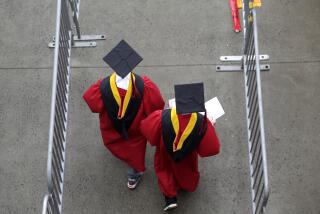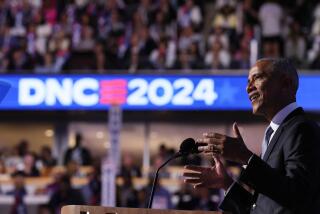College: THE UNDERGRADUATE EXPERIENCE IN AMERICA by Ernest L. Boyer (Harper & Row: $19.95; 352 pp.)
- Share via
Every 12 years or so, America’s colleges become an object of public scrutiny. This tends to occur during or following traumatic events in the life of the nation--World War I, the Depression, World War II, Sputnik and the ‘60s (civil rights, Vietnam and student protests). Each of these periodic assessments has sparked a national debate about the purposes and performance of higher education; changes in campus practice, frequently substantial; and an outpouring of publications. The last outpouring alone was sufficient to bring a boom to America’s timber and paper industries.
We are in the midst of another of these periodic reviews now. Spurred on by declining student test scores, questions about teaching and teachers, changing economic and political realities, and decreasing national competitiveness, books and reports have been issued by the U.S. secretary of education, National Institute of Education, the nation’s governors, education associations, college presidents, scholars and more.
Ernest Boyer’s “College” is by far the best of the current wave. It offers description and analysis of the present state of the American college and recommendations for the future.
What makes “College” so special is how it differs from the other volumes on the topic. First, it is comprehensive. The book deals with the full range of college- related matters--the connection between schools, college and the larger world; the goals and outcomes of undergraduate education; the academic program; teaching and learning; students and faculty; campus life, and institutional governance.
Second, it is very well documented. Boyer incorporates a mountain of data including massive surveys of faculty and students conducted in 1969, 1975 and 1984; surveys of almost half of the nation’s chief academic officers; surveys of high school students and their gu1768186222eminent education scholars, and field studies of a representative cross section of colleges and universities. Most of the data is new and was collected specifically for this volume.
Third, “College” is balanced. It is neither an homage nor a crucifixion of higher education. Boyer identifies eight very real problem areas ranging from school-college relations and faculty careers to the measurement of college outcomes and life outside the classroom. He suggests remedies for responding to each.
Fourth, “College” recognizes the essential heterogeneity of American higher education. There are 3,000 colleges and universities in this country. They are public and private. They are universities, colleges, two-year institutions and specialized schools. Some emphasize teaching, others research. Some offer vocational programs, others the liberal arts. Boyer’s book takes full cognizance of the diversity and texture of the system.
Fifth, “College” is very readable. The author avoids the jargon and educationese that characterize so much of the literature on this topic. Ernest Boyer, president of the Carnegie Foundation for the Advancement of Teaching and former U.S. commissioner of education, has a unique ability. He can make complex ideas comprehensible and esoterica popularly understandable. During the past decade, he has become, among other things, education’s equivalent of Carl Sagan.
He has written an important book. I did not expect to be as impressed with it as I am. Boyer’s recommendations, though thoughtful, are not panaceas. I don’t agree with several of them. No reader will agree with all of them. But even when one disagrees with Boyer, he makes you stop and think. And that above all else is badly needed today. This book offers the promise of an intelligent debate on the purpose and conduct of undergraduate education in America.
My one regret is that Boyer did not deal with the social context for scrutinizing the American college today--the issue of why now? But this is a quibble.
“College” is a book that deserves to be read. It is must reading for trustees, faculty and administrators at institutions of higher learning. The next few years at colleges will be a time of rethinking. Task forces and committees for this purpose are mushrooming on campuses all around the country. Moreover, the pressure on colleges to reconsider what they are doing is growing and will mount as our society enters a period of dramatic and continuing change, including a high technology revolution, the movement from an industrial to a service-information economy, the shrinking of the globe, massive demographic shifts and changing political priorities. This book offers the academic community a fresh portrait of the way things are, a vision of what could be, vignettes of institutions with model programs, and a useful epilogue--”Guide to a Good College,” which provides a list of questions every institution ought to ask about itself.
The epilogue will be helpful to another set of readers too--prospective college students, their parents and their guidance counselors and teachers. “College” is an unusual book for this audience. It goes far beyond what they need in depth and detail. However, there is no other guide currently available that gives as rich, complete and accurate a picture of contemporary campus life. “College” is well worth reading for this group.
It is also an interesting book for those of us who went to college and want to know what it is like today. Beyond this, it is essential for the people who plan to write the remainder of books and reports during higher education’s current periodic assessment. It just might save them the trouble and spare a few trees in the process.






